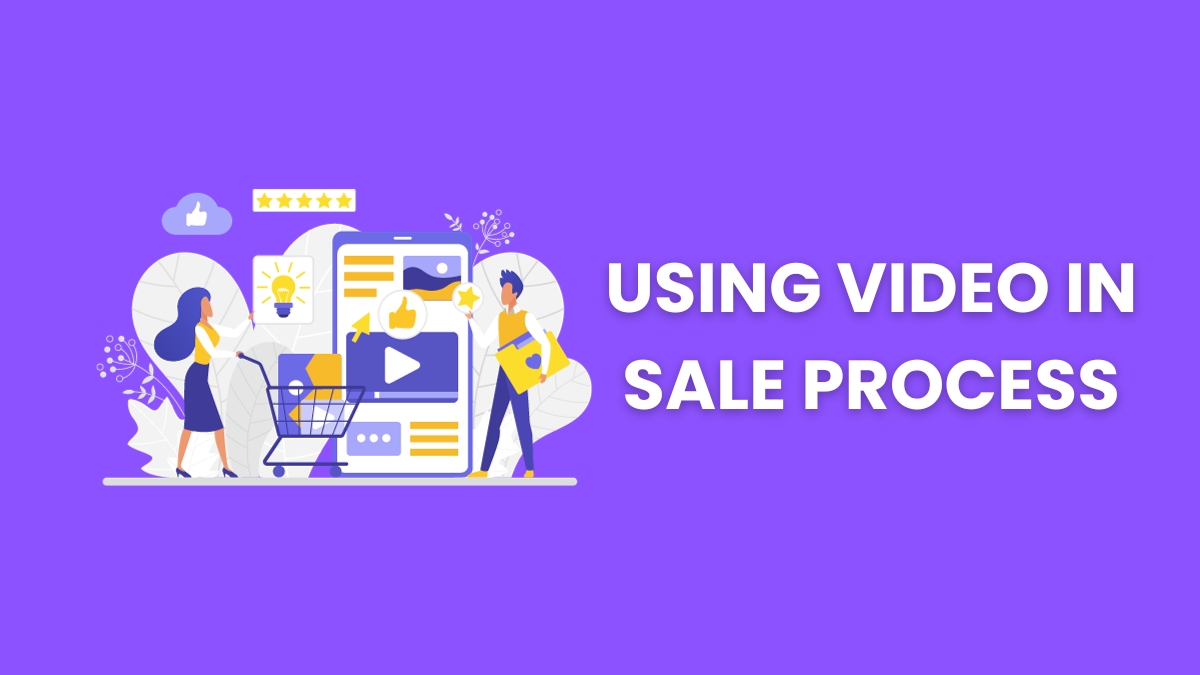How to Use Video as Part of Your Sales Process

We could learn a lot from history. Text-based advertising has been around since the 17th century, and image-based sales promotions have been in existence since the 19th century when poster advertising gained popularity. However, the real boom in sales and consumer spending started only in the 1950s and 60s, after the use of videos for sales promotion.
Why are we delving into history? In today’s challenging economic conditions and growing competition, even the best salesperson would find it hard to convert leads into paying customers.
Well, we have a solution. We recommend incorporating video into your sales process. One of the key traits of video content is its versatility. You can use videos whenever and wherever you want in the sales funnel.
Still skeptical? We’ll explain why and how to integrate video into your sales process.
How to Use Videos in the Four Crucial Stages of the Sales Process
Every sales cycle is unique, and some can be quite complex. Our four-stage sales cycle provides a solid starting point. Moreover, you can tailor it to align with your specific business requirements.
Prospecting and Brand Awareness Stage

Prospecting, the first stage of your sales process, involves identifying your ideal audience and determining if they require your product or service to address their pain points.
Establishing whether your potential customers need your product and can afford it sets the foundation for your entire video marketing campaign, including its budget, promotional strategies, and monitoring mechanism.
Now that you’re certain there is demand for your product, it’s time to create videos that will capture the attention of your prospective customers.
During the prospecting and brand awareness stage, your prospects are unaware of your existence. At this point, you’re competing with competitors—whether it’s one, two, a dozen, or more—for your prospects’ attention and a snippet of their time.
Consequently, the videos you create for this stage should be attention-grabbing, making the prospects sit up and take notice.
There is a tendency among brands to hit hard at prospects at the first opportunity they get. They bombard them with information, sales pitches, discounts, etc., aiming to create maximum impact at the first point of contact with a prospective customer.
However, this strategy is counterproductive and bound to fail. Your only goal at this stage is to grab attention so that the customer becomes aware of your product.
Certain types of videos perform exceptionally well at the initial stage of the sales cycle. You can use brand videos that showcase the values, mission, and vision of the company; documentaries and short emotional videos that tug at heartstrings; and educational and explainer videos that introduce the product in a simple and entertaining way.
While you have many video types to choose from, one, in particular, stands out. Animated videos are excellent at attracting attention and engaging and entertaining the audience. Animated videos provide unlimited room for creativity, and a video agency can take any complex idea and convert it into an engaging, easy-to-understand animated video.
IBM 5in5 Video (https://vimeo.com/82110215 )
Check out IBM’s 5in5 video. This animated video highlights the various ways technology can make life easier for people living in cities. The commercial video by IBM is self-explanatory, and in less than 90 seconds, it explains things that pages of text can’t. It captures eyeballs, entertains, and educates the audience.
Consideration and Objections Handling Stage

In the previous stage, you did everything possible to grab attention. Now, it’s time to present your product as the optimal choice to meet the needs of prospective customers.
The term ‘consideration’ is used because customers will assess all the physical and functional attributes of the product. Facilitate their decision-making by providing how-to, explainer, and other video types that educate prospects about your product.
If you’re seeking to craft a compelling narrative to promote your product or service, look no further than your business proposal. The product narrative that captures the hearts and minds of prospects is already within your business proposal.
As a brand, you may have a hundred things to say about a product. However, tailor the message to address the pain points of prospective customers. Provide customers with as much information as they need to make a decision. Audience persona research during your go-to-market phase will help you effectively tailor your message to your target audience. Utilize case studies, product demos, and how-to videos to showcase all the product functions and benefits offered to customers.
Your product may be one of the many that caught the attention of a prospective customer. The prospect would certainly compare the options before him/her. Along with the positives, the prospect would also weigh the negatives of each product.

It’s your duty to not only highlight the features, functions, and merits of your product but also to address objections, mitigate negative points, and alleviate any concerns the target audience has about your product.
A lot is happening at this stage of the sales cycle. The Consideration Stage is a complex and uncertain place where a wide variety of videos can be used. It’s also the stage where you need to truly connect and build trust with customers. To build trust, your word or promise isn’t enough. Back your word with evidence using case studies and testimonials.
Salesforce: Room and Board’s Case Study Video (https://youtu.be/djOeE24UnGY )
Here is a classic example of a case study video. It follows the ‘situation, problem, solution, and outcome’ template, visit captemp.pro for more interesting templates.. The video shows how Salesforce helped their client – Room and Board – overcome hurdles and achieve their business goals.
Converting and Closing Stage

You can gauge the significance of this stage from a single stat. According to research conducted by the Baymard Institute, 7 out of 10 ecommerce customers who add a product to their shopping cart don’t complete the purchase. Video content can play a crucial role in reducing cart abandonment rates.
To determine the type of video and content to create for boosting conversions, you need to first explore the reasons for cart abandonment.
- Customers may hesitate to take the extra step to purchase due to high product or delivery costs.
- Cart abandonment may increase due to a long, confusing, and complicated checkout process.
- Customers may still lack adequate information to justify spending money on the product.
- Simple procrastination can also be a reason for leaving the ecommerce website before making a purchase.
Based on the reasons for abandonment, there are many different videos you can create. Videos that simplify the buying process, provide discounts, and create urgency to finish the sale can reduce abandoned carts.
Sometimes, it becomes necessary to remind prospects why they decided to purchase a product. You can use explainer videos and testimonials to remind the audience of what they would gain by buying your product.
With email automation and personalized videos, you can send out video reminders to individuals and encourage them to complete the sale. Email marketing may not work with all categories of customers. You can run retargeting campaigns on Google and social media platforms to encourage prospects to go back to the product landing page.
TOMS: One for One (https://vimeo.com/79833962 )
Here is a beautiful product video that would be perfect for reminding prospects of the need to take the extra step – completing the sale. The video explains how the customer’s decision can improve the lives of people in so many ways.
The Follow-up Stage
You should be delighted that all the hard work invested in the previous stages has paid off. However, your job isn’t finished yet. There is still a significant opportunity to please the customer. Why?
Supporting customers even after the sale can lead to potential repeat business in the form of cross-selling and up-selling. Additionally, satisfied customers can be an excellent source of content creation (reviews, case studies, and testimonials) and more business (referrals).
Creating a post-sale strategy makes a lot of business sense. While both – new customer acquisition and customer retention – are important, focusing on customer retention can benefit the bottom line.
Experts believe that businesses have a nearly 70% chance of retaining existing customers. In contrast, in the case of acquiring new customers, the chance of sales drastically drops to just 20%.
Ways to use videos to delight and retain customers:

- Delight the customers after the sale using ‘Thank You’ and ‘Customer Onboarding’ videos. This strategy aims to reassure the customer and create goodwill.
- Utilize videos to provide customer support and resolve any issues efficiently and effectively. You could employ pre-recorded videos (FAQ videos) to solve common customer problems. Alternatively, screen sharing and screen grab stitched into videos using a video editor can be used to solve customers’ unique problems.
- The data you have on customer behavior and preferences can be used to create personalized videos for upselling and cross-selling to existing customers.
- Follow-up videos can be effectively used to reengage with old customers who have gone dark. Use personalized videos to create an instant impact and make them feel comfortable renewing their relationship.
NexaLog Claims and Refund Video (https://youtu.be/xtljNZAOrVI )
Customers expect a quick resolution to their complaints, especially in the case of returns and refunds. This simple video by NexaLog guides customers wanting a refund for a damaged package or product. The video works because the instructions are simple, useful, and come with helpful examples. Additionally, such post-sale videos also reduce the workload of the customer support team.
Tips for Effectively Creating and Using Video Content in Your Sales Process
There are dozens of little things that contribute to the creation of an effective video. The following are some tips that could significantly enhance the impact of your video content.
- Invest in customer research to identify the pain points of your potential customers. You can increase sales by focusing on solving customer problems. Explainer videos, how-to videos, testimonials, onboarding videos, etc., should predominantly focus on problem-solving rather than promoting your product.
- It’s said that customers form an impression within seven seconds of watching a video. Hence, hook the audience within the first few seconds of the video.
- Keep the videos concise and digestible. In ecommerce, in the majority of cases, you’re dealing with common, non-technical people. Therefore, use simple, easy-to-understand language and a casual tone in the videos.
- Use advanced tools to understand customer behavior and to present videos at the time and place frequented by the target audience. Also, employ the latest marketing strategies such as shoppable videos, shoppertainment, and live video shopping to engage customers and boost sales.
- A strong call to action is a must in every video, regardless of where in the sales cycle it’s used. CTAs encourage action, resulting in better lead generation, and ultimately higher sales.
Final Thoughts
To sum up, nothing fits better than video content in the sales process. Video content can be utilized at any stage of the sales process.
At each juncture, videos excel at engaging and convincing the audience. With AI and advanced video production and editing tools available these days, video has become an integral and indispensable part of the sales process.
How do you intend to incorporate video into the sales process? Share your ideas and opinions with us.
